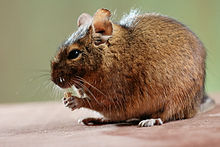
Octodon is a genus of octodontid rodents native to South America, in particular in the Chilean Andes. The best-known member is the common degu, O. degus, which is kept as a pet in various countries. Two of the four species of degus are nocturnal.

The Hystricognathi are an infraorder of rodents, distinguished from other rodents by the bone structure of their skulls. The masseter medialis passes partially through a hole below each eye socket and connects to the bone on the opposite side. This, together with their lack of an infraorbital plate and the relative size of the infraorbital foramen, distinguishes hystricognaths from other rodent groups.

Chinchilla rats or chinchillones are rodents of the family Abrocomidae. This family has few members compared to most rodent families, with only nine known living species. They resemble chinchillas in appearance, with a similar soft fur and silvery-grey color, but have a body structure more like a short-tailed rat. They are social, tunnel-dwelling animals, and live in the Andes Mountains of South America. They are probably herbivorous, although this is not clear.
The golden viscacha rat or golden vizcacha rat is the single species of the genus Pipanacoctomys of the rodent family Octodontidae. It has 92 chromosomes and has been regarded as tetraploid. This octodontid and its sister-species, the plains viscacha rat, may have arisen from the diploid mountain viscacha rat, as a result of the doubling and subsequent loss of some chromosomes. However, some genetic studies have rejected any polyploidism in mammals as unlikely, and suggest that amplification and dispersion of repetitive sequences best explain the large genome size.

Bennett's chinchilla rat is a species of chinchilla rat in the family Abrocomidae. It is found only in Chile where its habitat is Mediterranean-type scrub on the western side of the Andes. The IUCN has assessed its conservation status as being of "least concern".

The Chilean rock rat is a species of rodent in the family Octodontidae. It is found in the high Andes of Argentina and Chile.

The mountain degu is a species of rodent in the family Octodontidae. It is the only species in the genus Octodontomys. It is found in the foothills of the Andes in Argentina, Bolivia and Chile.
The mountain viscacha rat or mountain vizcacha rat, historically viscacha rat or vizcacha rat, is a species of rodent in the family Octodontidae. It is endemic to Argentina.

The coruro is a species of rodent in the family Octodontidae. It is the only species in the genus Spalacopus. The species is endemic to central Chile, where it has been found in a wide variety of habitats, from coastal to montane. It is fossorial and lives in colonies.

The plains viscacha rat, plains vizcacha rat, red viscacha rat, or red vizcacha rat is a species of rodent in the family Octodontidae native to Argentina. It is one of three species in the genus Tympanoctomys.

Tympanoctomys is a genus of rodent in the family Octodontidae. There are three extant species in the genus: T. barrerae, T. kirchnerorum and T. loschalchalerosorum. T. loschalchalerosorum was formerly considered to be monotypic within the genus Salinoctomys, but has been shown by genetic analysis to nest within the variation of T. barrerae.
Viscacha rats are a group of rodents in the family Octodontidae. All species are found in Argentina. They are placed in the following genera:
The Chalchalero viscacha rat or Chalchalero vizcacha rat is a species of caviomorph rodent in the family Octodontidae. It was formerly considered to be monotypic within the genus Salinoctomys, but has been shown by genetic analysis to nest within Tympanoctomys, and in particular, within the variation of T. barrerae. The species is endemic to a small area of northwestern Argentina, where it lives in shrublands bordering the salt flats of the Salinas Grandes. Its diet consists of halophyte plants. It is named after an Argentine musical group, Los Chalchaleros, whose songs were popular with its discoverers.
Bridges's degu is a species of rodent in the family Octodontidae. It is found in southern Chile. The species was named after Thomas Bridges.
The 2000s witnessed an explosion of genome sequencing and mapping in evolutionarily diverse species. While full genome sequencing of mammals is rapidly progressing, the ability to assemble and align orthologous whole chromosomal regions from more than a few species is not yet possible. The intense focus on the building of comparative maps for domestic, laboratory and agricultural (cattle) animals has traditionally been used to understand the underlying basis of disease-related and healthy phenotypes.
Kirchner's viscacha rat or Kirchner's vizcacha rat is a species of rodent in the family Octodontidae described in 2014. It is one of three species in the genus Tympanoctomys. That species is endemic to Chubut Province in the central western Argentina, where it has a fragmented range. Its natural habitat is desert scrubland, dunes and salt flats, where it eats halophyte plants. It is a solitary, nocturnal rodent that constructs large mounds with complex burrows. The species was named in honor of both Cristina Fernández de Kirchner and Néstor Kirchner, presidents of Argentina.
The Degus are a group of octodontid rodents in the Octodontidae family, but historically referred to the common degu.







